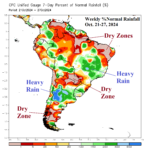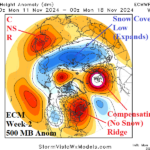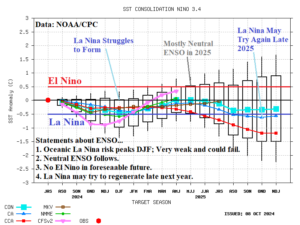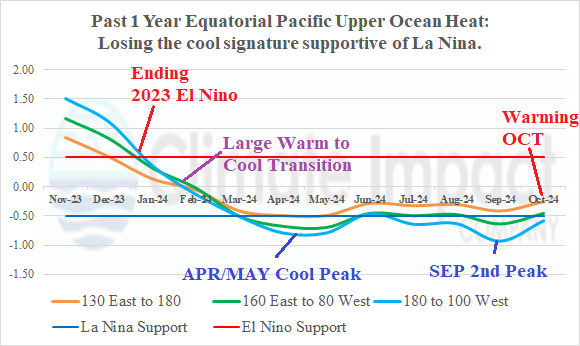
MJO-Inspired Brazil Rains
10/29/2024, 5:36 am EDT
The Ridiculously Resilient Ridge Pattern
11/05/2024, 4:41 am EST 
Fig. 1: The 12-month equatorial Pacific Ocean upper ocean heat anomalies.
Discussion: The Australia Bureau of Meteorology adds the following statement to their ENSO outlooks: “Global SSTs remain at near record levels, with temperatures since July being just short of the record temperatures observed during 2023, yet above all other years since observations began in 1854. The sustained nature of this significant global ocean heat suggests that climate indicators such as ENSO and IOD may not behave or evolve as they have in the past.” This statement is paramount to understanding ENSO regimes nowadays. Predictability of ENSO and IOD and their understood correlations to regional climate patterns are disrupted due to the widespread warming of the global oceans (particularly in the middle latitudes). Consequently, as important as ENSO, are the observation and projection of marine heat waves (MHW) which identify regions of the oceanic warming.
Historically, a reliable predictor of ENSO phase is the observation and trend of equatorial Pacific Ocean upper ocean heat. A classic deceleration of upper ocean heat fueling the 2023 El Nino toward much cooler than normal subsurface temperatures occurred earlier this year (Fig. 1). The cooling peaked in APR/MAY. At that time, the interpretation of this dramatic cooling was a “La Nina ahead” signal.
However, the subsurface cooling eased through mid-year and although a second peak occurred in SEP, the OCT values find a significant loss in the cool subsurface intensity which suggests fuel to drive a La Nina onset is fading.
So where does this leave us regarding ENSO phase ahead? The best forecast may be the various Nino34 SSTA predictions from NOAA (Fig. 2) which indicate neutral to very weak La Nina through the next several months followed by neutral ENSO for much of next year with another attempt at generating La Nina later next year. Cold ENSO may need two attempts to generate given the suppressing effects of the surrounding anomalous warm ocean.
This conclusion is tricky. Doubting oceanic La Nina does not mean that atmospheric La Nina fails. Multivariate ENSO index (MEI) indicates a weak La Nina atmosphere formed a few months ago. The La Nina climate can form due to the comparably much warmer water of the subtropics in both hemispheres and western tropical Pacific.

Fig. 2: The NOAA/CPC Nino34 SSTA forecast models to determine ENSO phase into early 2026.

